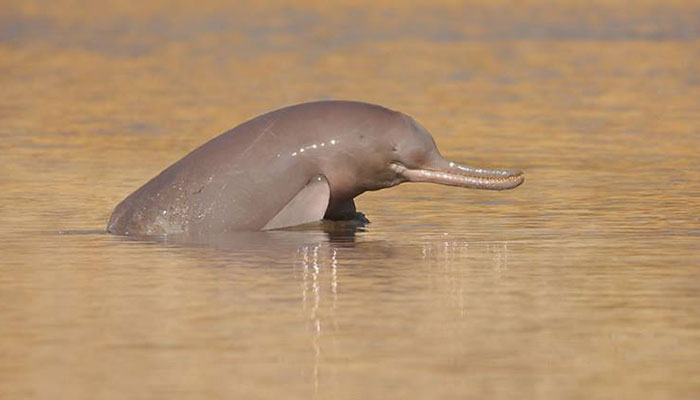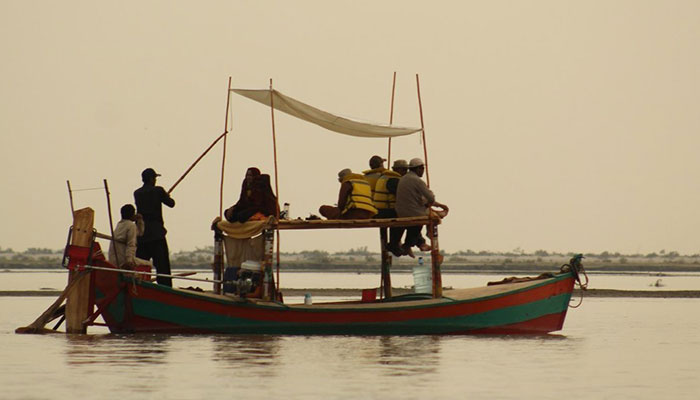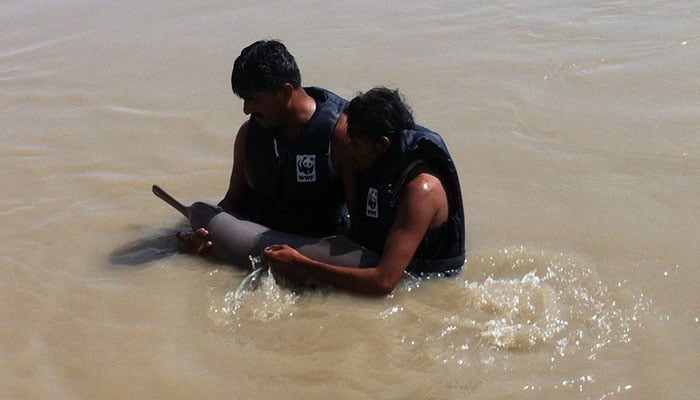Indus River Dolphin numbers on the rise, WWF study reveals
The 'blind' dolphin population has increased from only 1200 in 2001 to 1816 -1900 in 2017
December 15, 2017

The number of the endangered Indus River dolphin, also known as bhulan or the ‘blind dolphin’, is on the rise – a significant positive development despite pollution threat, a study conducted by WWF Pakistan has revealed.
In its report titled ‘Signs of Hope for the Endemic and Endangered Bhulan,’ WWF Pakistan noted that the species, almost at point of extinction a decade ago, has increased in number from only 1,200 in 2001 to 1816 -1900 in 2017.
The study, conducted by a team of experts from the Zoological Survey Department of Pakistan, WWF Pakistan, academic researchers from various educational institutions and the wildlife departments of Sindh, Punjab and Khyber Pakhtunkhwa, concluded at least 1,816 dolphins were sighted in the long stretch of 808 kilometres of the main channel of the Indus River.
The blind dolphin is an obligate freshwater cetacean species found in the Indus River, Pakistan. It is the second most endangered freshwater dolphin species in the world, the first being the 'functionally extinct' Yangtze River dolphin.
“Direct count results for the sub-population between Chashma-Taunsa barrages were 84, 82, 87 and 170 for the year 2001, 2006, 2011 and 2017 respectively. Between Taunsa and Guddu, similarly, direct counts have been steadily rising from 259 in 2001, to 465 in 2011 and 571 in 2017. The last sub-population surveyed between Guddu-Sukkurr barrages, which historically hosted the highest population of the Indus River dolphin also indicated a similar significant increase in the population from 602 in 2001 to 1,075 in 2017,” said the study, compiled from March 20 to April 13, 2017.
Threats
The study pointed out key threats to the Indus River dolphin, including water regulatory barrages, canal closures, unsustainable fishing practices, and contamination of river water due to agrochemicals and industrial waste.

“Indus dolphins tend to move to irrigation canals through flow regulator gates, adjacent to barrages, throughout the year. When closed for canal maintenance, dolphins are stranded due to sudden water shortage in canals… Intensive fishing in the core habitat of the Indus dolphin is one of the key threats to its population, with high probability of dolphin mortality from entanglement in fishing nets, especially when they move into easily accessible and heavily fished irrigation canals. Habitat fragmentation and degradation due to extraction of water in the dry season and pollution are amongst the prime threats faced by the Indus River dolphin..,” the study observed.
What is WWF Pakistan doing to conserve Indus dolphin?
WWF Pakistan says it has adopted a participatory approach to working for the conservation of this endangered and endemic species.
A dolphin rescue programme has been in place since 1992, jointly led by WWF Pakistan and the Sindh Wildlife Department to rescue any stranded dolphins from canals and safely release them back into the main river channel.
Of a total 147 dolphins reported trapped in canals between 1992 to 2017, 131 dolphins were rescued successfully and released into the river, while only one individual died during the rescue operation, the report said.

WWF Pakistan and the Sindh Wildlife Department have also established a dolphin monitoring network in collaboration with relevant stakeholders and local communities to monitor the Indus River as well as its adjacent canals and tributaries to rescue any stranded dolphins.
As per the report, the teams have conducted over 100 monitoring surveys since 2015 to stop illegal fishing and to rescue stranded dolphins, with 12 successful rescues during 2016.
A 24-hour phone helpline has also been set up to report any incidences of stranded river dolphins.
Hamera Aisha, Manager Conservation (Wildlife), WWF Pakistan, told Geo.tv that communities can play a very important role in conserving the Indus dolphin.
"Research and conservation priorities need to strengthen to rescue dolphins from canals, continued population monitoring, together with community-based in-situ conservation are important. Stranding in canals is a persistent problem and loss of dolphins is inevitable without timely rescues. It is important to experiment with various options that can help to control the number of dolphins entering irrigation canals," she said.
Freshwater fishing is one of the major sources of livelihood for riverine communities, she noted, adding that an increase in the incidences of illicit fishing activities is directly proportional to the fishing gear-induced mortalities in dolphins.
"Hence, a revision in the existing provincial fisheries legislation to control illegal fishing is critical, and so is enhanced community participation in dolphin monitoring and rescue programmes through capacity building and awareness raising."
The official pointed out that WWF Pakistan initiated a dolphin rescue telephone helpline service where citizens could report any incidence of dolphin stranding or entanglement.
"This has helped to increase the citizen-based observer coverage of the dolphin habitat. One way to support this work is to help with these efforts and also to support WWF Pakistan through becoming its members and joining as volunteers," she said.
Quick facts
The Indus River dolphin can be identified by its long beak, rounded belly, stocky body, very small dorsal fin and large flippers.
The Indus River dolphin is blind but can still differentiate between light and dark.
The Indus River dolphin swims on its side – a style not consistently seen in any other dolphin, except the Ganges River Dolphin.
The blind dolphin migrates upstream into the smaller tributaries during the monsoon rains and migrates downstream to the main channels in the dry season.











